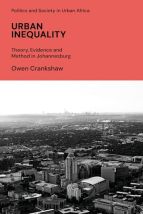Urban Inequality: Theory, Evidence and Method in Johannesburg

Crankshaw’s volume builds on earlier work to provide a comprehensive analysis of economic and social inequality in Johannesburg. This argument in this new book centres on Crankshaw’s interrogation of two dominant theories that have emerged in Europe and the United States to explain observed changes in urban-based labour market opportunities, and then moves to report on and analyse changes in Johannesburg’s residential neighbourhoods.
The first part of the book focuses on labour markets, with the author beginning by summarizing research to date on the professionalization and social polarization theses to explain labour market changes, then using these theses to examine changes in employment patterns. Crankshaw draws on existing data sets – population censuses and household surveys – as the basis for an original analysis. The analysis draws on data from 1970 to 2011 with a greater focus on the later period. He concludes that deindustrialization has taken place in Johannesburg alongside a growth in service sector employment. In terms of long-term employment trends, he finds that “the employment of middle-income, manual workers grew only slightly, with much faster growth in high-income, low-income and non-manual middle income occupational groups” (page 42). He argues that the employment data between 1979 and 2011 does not support social polarization theory, but there is some support for the professionalization theory. Crankshaw concludes that there is evidence that the demand for workers with higher levels of education has increased, indicating skills mismatch, but he also explains that growth in the labour force is a significant factor explaining high levels of unemployment.
Chapter 3 analyses changing patterns of racial inequality in relation to employment and labour markets, and reports on the considerable changes in the racial composition of high-income middle class (managerial, professional and technical job categories) employment. He argues that trends are very much related to a growth in middle income non-manual jobs. Black Africans employed in middle-income semi-skilled manual jobs have had mixed fortunes but others have benefited from a growth in non-manual middle-income employment. Africans and coloured groups are significantly more likely than Indian and white groups to be unemployed. And even those who have completed secondary school have high rates of unemployment in part linked to a poor quality of education in low-income neighbourhoods. White workers continued to be well placed due to a growth in opportunities of middle- and high-income non-manual jobs. Within this analysis, Crankshaw explores a number of relevant policy and programming interventions including access to educational opportunities, and measures undertaken by the government to increase the opportunities open to previously disadvantaged groups.
The second substantive part of the book considers changing patterns of spatial inequality, analysing the interaction between housing and labour markets, and the scale and nature of neighbourhood desegregation. Crankshaw explores the validity of patterns of spatial exclusion and changing economic geographies developed for US cities in the context of Johannesburg. Drawing on concepts of the “edge city” and “excluded ghetto” and an original analysis of the 1996, 2001 and 2011 population censuses, he documents the changing locations of middle-income and unemployed residents (differentiating between African, Indian and coloured groups) and explores theories that potentially explain these residential shifts. This analysis is linked to the changing occupational composition of the middle class away from manual labour and towards non-manual work. In summary Johannesburg now includes “an edge city with a racially mixed middle-class population … and an excluded ghetto with high levels of unemployment alongside an employed workforce of largely middle-income workers” (page 194). Crankshaw discusses the comparability of his findings for Johannesburg with those in US cities, concluding that outcomes in Johannesburg are not consistent with observed trends in the US.
This book provides a wealth of insights for those seeking to understand urban poverty and inequality in South Africa. Original analysis of datasets adds insights into changing patterns of occupational inequality and mobility, while the spatial analysis elaborates on choices about changes in residential location and examines the desegregation of the apartheid city. The engagement with theories from the global North both in terms of labour markets and the spatial dynamics within cities, offers new understandings for both theory and policy.
Book Note prepared by Diana Mitlin.
Search the Book notes database
Our Book notes database contains details and summaries of all the publications included in Book notes since 1993 - with details on how to obtain/download.
Use the search form above, or visit the Book notes landing page for more options and latest content.
For a searchable database for papers in Environment and Urbanization, go to http://eau.sagepub.com/

